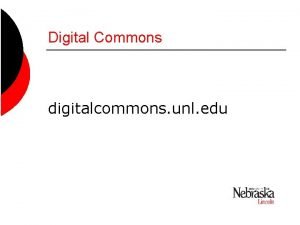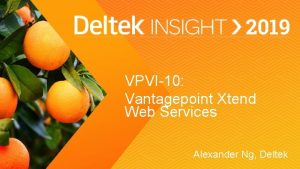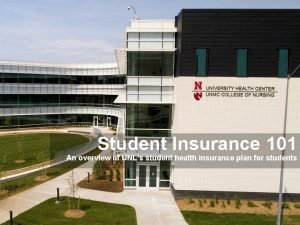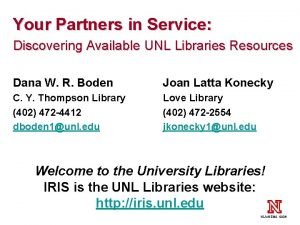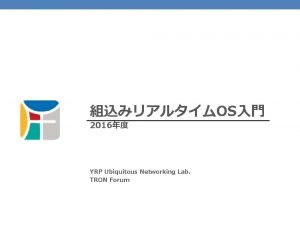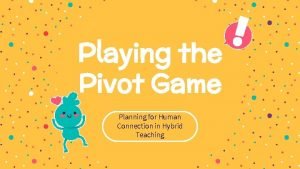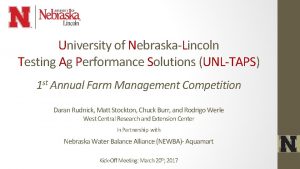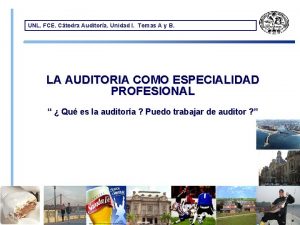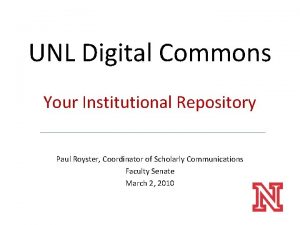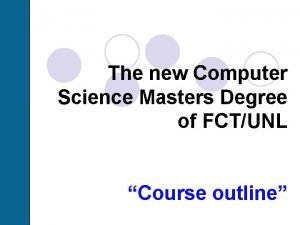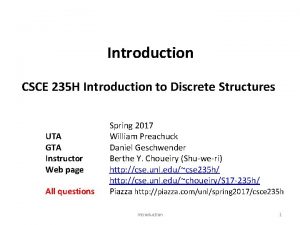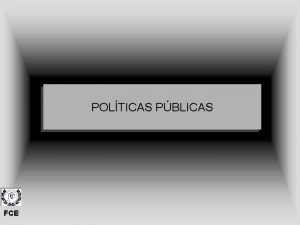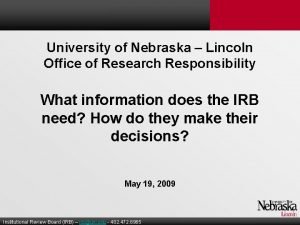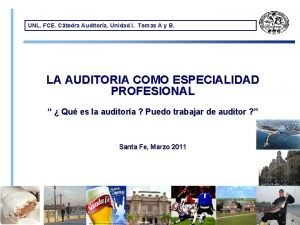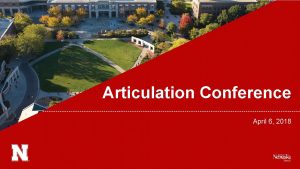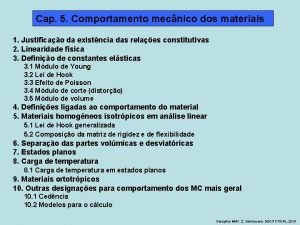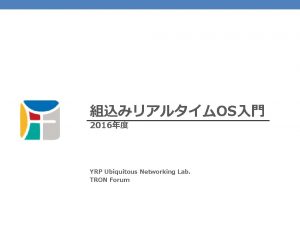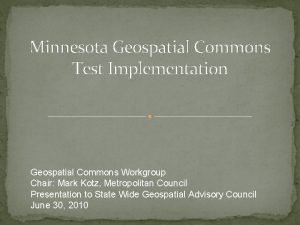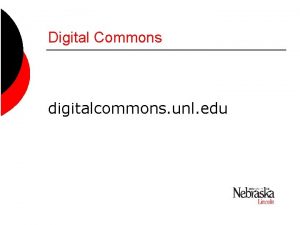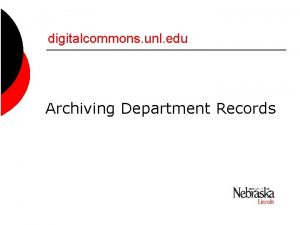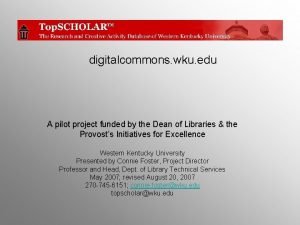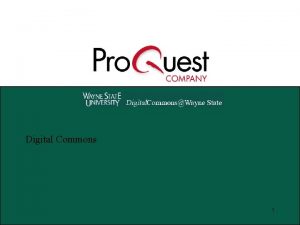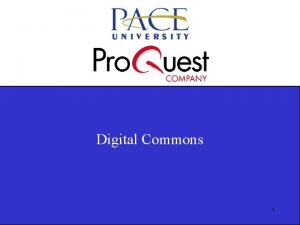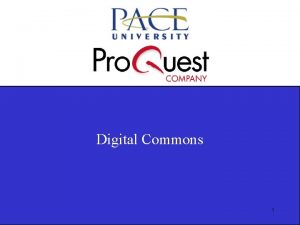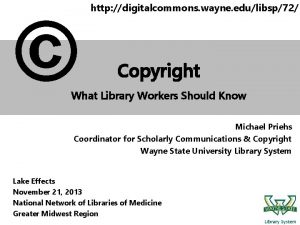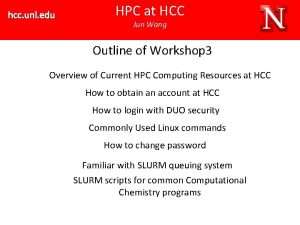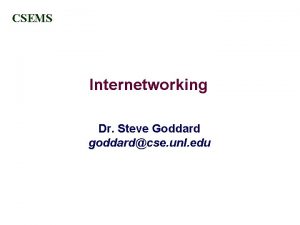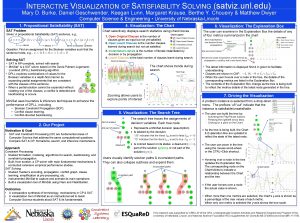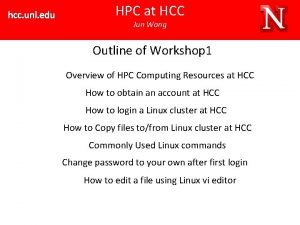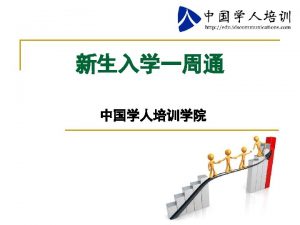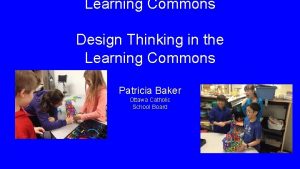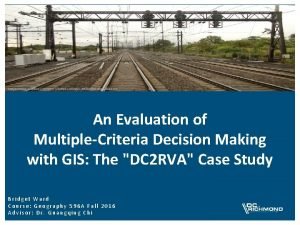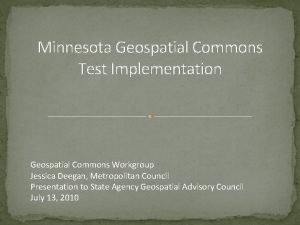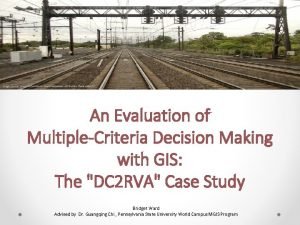Digital Commons digitalcommons unl edu Digital Commons is


























- Slides: 26

Digital Commons digitalcommons. unl. edu

Digital Commons is: • a new program started by the Libraries in June 2005 • an “Institutional Repository” (IR) = an electronic archive for UNL-related documents • an opportunity for electronic publishing

The “Institutional Repository” (IR) • receives and archives one electronic copy • preserves this copy permanently in the UNL Libraries collections • creates a stable URL with a unl. edu address • provides and controls electronic access • migrates the data as formats evolve

Electronic Publishing • places scholarly publication tools directly in the hands of the faculty: publishing online requires 1) MS Word, 2) a browser, 3) an email address • each publication series is controlled by its own editorial board • no limits on article length or number, size, or colors of illustrations • “Freedom of the press is limited to those who own one. ”-- A. J. Liebling

What does it contain ? (1/24/06) • 9, 465 UNL dissertations • 970 articles, ebooks, & presentations • 1 electronic journal • 137 “communities” • 159 series • Works from more than 80 UNL faculty & researchers

Who goes there ? (or how many ? ) • Over 126, 000 “hits”, July-Dec 2005 Hits/download conversion, dissertations = 20% Hits/download conversion, articles = 40% • Over 31, 000 downloads, July-Dec 2005 • Currently averaging >2, 000/week About 25% dissertations About 75% (and growing) articles & ebooks • Most downloaded work: “Online Dictionary of Invertebrate Zoology” (3, 713)

Benefits: online work is • accessible immediately, 24/7, worldwide • visible to common search engines (such as Google and Google Scholar) • viewed and cited more frequently, especially by students • identified with the author’s name and date of submission • collected together in one place • permanently housed, even after you retire or move to another institution or different “plane of existence”

Who controls the copyright ? • the author or author-entity or the party to whom copyright has been sold or licensed by the author • not the library; not the university (unless by separate agreement) • Online publication does not affect the copyright of previously published works. • Online publication establishes copyright for previously unpublished works.

Rights to published works • 92% of journals allow pre-publication posting to an IR • 60% of journal publishers have blanket policies allowing post-publication deposit • most of the remaining 40% of publishers will give authors permission to deposit in their home institution’s repository

Publishers with policies permitting archiving: • • • • American Economics Association American Institute of Physics American Mathematical Society American Psychological Association Am. Soc. of Biochemistry and Molecular Biology American Society of Plant Biologists Annual Reviews Arnold Publishers Bio. Med Central Biophysical Society Blackwell BMJ Publishing Group CAB International Cambridge University Press • • • • Ecological Society of America Elsevier Haworth Press John Wiley & Sons Johns Hopkins University Press Kluwer Marcel Dekker National Academy of Sciences Nature Publishing Group Oxford University Press Sage Springer Verlag Taylor & Francis University of California Press University of Chicago Press Source: http: //www. sherpa. ac. uk/index. html

The Library wants to publish your: • Previously published articles • Presentations, talks, unpublished manuscripts • Out-of-print books • Hard-to-find texts & documents • Teaching materials • Research, scholarship, or creative activity of any kind

The Digital Commons offers: 1. Immediate electronic publication, with 24/7, worldwide, free access to materials 2. Design & typesetting services 3. Permissions & copyright clearance 4. Regular usage reports by email 5. Permanent URL for linking 6. Long-term archiving, storage, and migration.

Getting started: the D. I. Y. model 1. Find an existing series; or establish a new one (1 -page questionaire) 2. Log in to register and receive a password at http: //digitalcommons. unl. edu/cgi/myaccount. cgi 3. Begin uploading your own Word or pdf files Submitting an article takes less than 2 minutes.

Getting started: the D. I. F. M. * model 1. Email me your vita or list of publications: proyster@unl. edu 2. (There is no step 2. ) *D. I. F. M. = “Do it for me”

To establish your own “series” 1. Decide its affiliation or sponsoring “community” (department, school, college, etc. ) 2. Give it a name 3. Recruit or volunteer the series editor(s) 4. Email the information to proyster@unl. edu You can publish your own work, plus work from colleagues at this or any other institution.

Site structure


Costs • There are no costs to the publishing unit. • Hardware, set-up, programming, maintenance, and support costs are paid by the UNL Libraries.

Why put work online? • Widest possible access—delivered directly to the screen (and hard drive) of any Internet-connected computer, anywhere, anytime. • Full text is linkable from any web page, email, vita, or hypertext document. • Build and enhance an online presence, identity, and reputation.

“But my article is already online. . . ” Is it. . . • Free? Or behind a wall—for paid users only? • Available off-campus, in hotels, airports, internet cafes? • Available in Delhi, Lagos, Beijing, or Bagdad? • At its own linkable URL, or at the end of a Java search syntax? • Indexed by Google? • Contributing to the unl. edu domain? • Accessible to your mother?

A cybernetic experiment: • “Google” your article title and see what you get. • Is there a free-access, full-text version listed in the top 10 results? • If not, then the Digital Commons can possibly help put one there.

What if I change my mind ? • The depositor or editor can post a revised version or change the “metadata” at any time, from any connection. • Any article can be withdrawn by the depositor or editor at any time; it will no longer show up on the site.

What does the Library get out of it ? • Access • Dissemination • Preservation • Collection development • Recruitment of faculty • Enrollment of students

Contact Paul Royster Coordinator of Scholarly Communications UNL Libraries 306 Love Library 402 472 -3628 email: site: proyster@unl. edu http: //digitalcommons. unl. edu/

Places to visit: Front door: http: //digitalcommons. unl. edu/ Main directory: http: //digitalcommons. unl. edu/communities. html ODIZ: http: //digitalcommons. unl. edu/onlinedictinvertzoology/ Music Performance: http: //digitalcommons. unl. edu/musicperform/ Podcasts: http: //digitalcommons. unl. edu/podcast 1/ Ornithology: http: //digitalcommons. unl. edu/biosciornithology/ Vert Pests: http: //digitalcommons. unl. edu/vpcthirteen/ Library Faculty Pubs: Timoleon, Etc. http: //digitalcommons. unl. edu/libraryscience/16/ De bestiis marinis http: //digitalcommons. unl. edu/libraryscience/17/ Pynchon chronology http: //digitalcommons. unl. edu/libraryscience/2/

Google searches http: //www. google. com/ Richard Wright Pagan Spain Lyly Midas Ultraviolet Birds of Nebraska Joshua Scottow primase structure and function androsynhesmia (= “A group of males gathered together during mating season. ”)
 Digitalcommons unl edu
Digitalcommons unl edu Edu.sharif.edu
Edu.sharif.edu Deltek unl
Deltek unl Unl student insurance
Unl student insurance Unl interlibrary loan
Unl interlibrary loan Forum unl
Forum unl Unl canvs
Unl canvs Unl taps
Unl taps Unl fce
Unl fce Royster commons
Royster commons Unl masters programs
Unl masters programs What is discrete math
What is discrete math Sga unl
Sga unl Nugrant unl
Nugrant unl Unl fce
Unl fce Abby freeman unl
Abby freeman unl Dec fct unl
Dec fct unl Forum unl
Forum unl Data encoding and modulation
Data encoding and modulation E-commerce digital markets digital goods
E-commerce digital markets digital goods Yang dimaksud dengan kewargaan digital
Yang dimaksud dengan kewargaan digital E-commerce: digital markets, digital goods
E-commerce: digital markets, digital goods Unique features of digital markets
Unique features of digital markets Digital encoding schemes
Digital encoding schemes Digital data digital signals
Digital data digital signals Rdi board
Rdi board Minnesota geospatial commons
Minnesota geospatial commons
